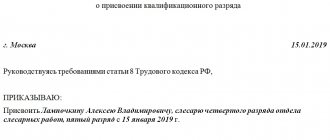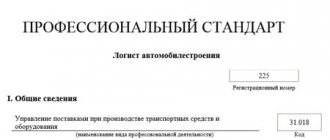ASSIGNMENT OF QUALIFICATION CATEGORIES TO SPECIALISTS
Assignment of qualification categories to specialists is carried out in the manner determined by the collective agreement, agreement or employer in accordance with the qualification characteristics of specialist positions provided for by the ECSD, taking into account the recommendations of the certification commission.
When assigning a qualification category, the complexity of the labor functions performed by a specialist, the degree of independence in performing them, his responsibility for the work performed, an initiative and creative attitude to work, the efficiency and quality of work, as well as practical experience determined by length of service in the specialty, professional knowledge and etc. (clause 20 of the General Provisions of the ECSD).
Thus, Article 61 of the Labor Code of the Republic of Belarus provides that the assignment of work performed to specific tariff categories (positions) and the assignment of appropriate qualifications to employees are carried out in the manner determined by a collective agreement, agreement or employer on the basis of qualification reference books approved in the prescribed manner.
Taking into account the specified legal requirement, the organization, on the basis of a local regulatory legal act (for example, regulations on the assignment of qualification categories), establishes a procedure for assigning qualification categories to specialists.
Hiring an employee as a specialist of the 1st or 2nd category cannot serve as a basis for assigning the appropriate qualification to the employee.
A qualification category is considered assigned only if this decision was made at a meeting of the certification commission and approved by order of the employer, and a corresponding entry was made in the employee’s work book.
Qualification categories are assigned to those specialist positions for which the qualification characteristics of the ECSD provide for intra-position categorization, and in the order and on the conditions that are provided for by the relevant qualification requirements. At the same time, specialists who have the education and work experience in the relevant positions provided for in the qualification characteristics are allowed to undergo certification (clauses 22, 23 of the General Provisions of the ECSD).
For the position “Accountant”, contained in issue 1 of the ECSD, approved by Resolution of the Ministry of Labor of the Republic of Belarus dated December 30, 1999 No. 159, taking into account changes and additions, the following qualification requirements are provided:
Accountant of the 1st category: higher professional (economic) education and work experience as an accountant of the 2nd category for at least 3 years.
Accountant of the 2nd category: higher professional (economic) education and work experience as an accountant for at least 3 years.
Accountant: higher professional (economic) education without requirements for work experience or secondary specialized education without requirements for work experience.
Taking into account these qualification requirements, an accountant can be assigned the 2nd qualification category only if the employee has work experience as an accountant for at least 3 years, and the 1st qualification category is assigned if he has work experience as an accountant of the 2nd qualification category at least 3 years respectively.
If the qualification requirements provide for additional conditions (for example, for a customs clearance specialist, the employee is required to have a qualification certificate as a customs clearance specialist, as well as undergo advanced training courses for customs clearance specialists once every 3 years), the employer is obliged to take them into account as upon appointment to this position, and upon assignment of a qualification category to this employee. Moreover, the employer may, in accordance with the established procedure, provide, along with the requirements for qualification characteristics, additional requirements for knowledge, professional training, work experience, etc. when assigning a qualification category to specialists in the corresponding field of activity (clause 23 of the General Provisions of the ECSD).
When assigning a qualification category to specialists, the employer has the right, on the basis of a local regulatory legal act, to establish additional requirements along with those existing in the qualification characteristics (for example, for some specialist positions - the requirement of knowledge of a foreign language, completion of advanced training courses, etc.).
Qualification categories are assigned to employees sequentially (second, first, highest), and their further confirmation is not required, unless otherwise provided by law (clause 24 of the General Provisions of the ECSD).
Thus, the certification commission may recommend that an employee who has worked for at least 3 years as an engineer without a category be assigned the 2nd qualification category, but the 1st qualification category for the position of engineer can be assigned to this employee, provided that his work experience as an engineer Category 2 will be at least 3 years.
As an exception, a specialist who does not have a qualification category and is appointed (accepted) to a position may be assigned a qualification category provided that he has work experience provided for by the qualification requirements of the qualification characteristics of the corresponding position, incl. experience in leadership positions in this area of activity. This takes into account his practical work experience, as well as the business and personal qualities of the specialist, the level of his professional knowledge, skills and abilities (clause 25 of the General Provisions of the ECSD).
A specialist working as an accountant and having 10 years of experience as a chief accountant (deputy chief accountant, leading accountant, bookkeeper) is entitled by the employer to assign the 2nd or 1st qualification category in the manner established by the local regulatory legal act of the organization. The criterion in this case is whether the employee has work experience, which must be no less than the total work experience in the relevant positions provided for by the qualification requirements for the 2nd and 1st categories. For example, for an accountant of the 1st qualification category, this experience will be at least 6 years (3 years + 3 years).
The specifics of assigning qualification categories to specialists in certain industries are regulated by relevant regulatory legal acts (clause 26 of the General Provisions of the ECSD). The assignment of qualification categories to individual specialists (health care workers, education workers, etc.) is established by industry regulations. In addition, for certain categories of specialists in these industries, the qualification characteristics provide for the highest qualification category.
Superficial division of engineers into categories
In domestic practice, there are the following categories of engineers:
- Lack of category. Workers with this specialization will be able to perform only the simplest actions. Moreover, they cannot make any decisions unless they are supervised by more qualified professionals.
- Category 3. Such workers can perform the responsibilities of engineers described above. In addition, they can develop simple drawings. Naturally, they will perform all work only under the strict supervision of specialists of higher categories.
- 2nd category. Workers cope with the responsibilities listed above, without the supervision of professionals. In addition, they have access to the development of drawings for individual parts or small simple assemblies. In some cases, designers independently assemble such parts according to the created drawings.
- 1st category. The employee performs all of the above actions. In addition, if the manager or leading engineer gives certain instructions for the creation of new units, then the engineers can and are obliged to carry them out.
The leading engineer can also be noted. He is involved in the development of all major structures that are used at the enterprise. Plus, they can optimize existing systems and units and develop equipment that will become more competitive.
Specialist rights
The leading engineer has the following rights exercised at the workplace:
- Demand, through the head of the technical department, to stop the production and production of individual elements, parts and assemblies if they differ from the specified author’s design parameters.
- Defend the correctness of the decision made based on his project of an object or structure.
- Take direct part in technical discussions of designed structures and developments.
Engineers category 3
A category 3 engineer is a performer who carries out orders and instructions from senior management. Usually the role of the latter is played by more qualified specialists. Despite the fact that the engineer performs the bulk of his work under close supervision, he can do some actions independently:
- Choose auxiliary materials that will be more convenient for him to use.
- Independently improves his skills and studies the necessary materials.
- Develops documentation and signs it before handing it over to the manager.
Thus, despite limited obligations, all category 3 engineers represent an independent working unit that needs to coordinate its actions with specialists.
How to apply for an upgrade?
We wrote more about it here.
Usually the role of the latter is played by more qualified specialists.
Persons who do not have special training or work experience established by the qualification requirements, but have sufficient practical experience and perform their job duties efficiently and in full, on the recommendation of the certification commission, as an exception, can be appointed to the corresponding positions in the same way as and persons with special training and work experience.
That is, it is possible to assign category 2 to the employee in question.
Assignment and improvement of qualification categories to employees is carried out on the basis of recommendations of certification commissions. When preparing recommendations on the assignment of qualification categories, the following factors are taken into account: the profile of the organization, the level of theoretical training and practical skills, compliance with the qualification characteristics (job descriptions) of specialists and work experience.
Engineers 2nd category
An engineer of category 2, when performing his activities, must be guided by the regulatory documents of the organization in which he works. Also within his competence is the development of estimates and other documentation.
As a rule, the main job of category 2 engineers is to receive tasks from higher management, then divide them among subordinates. But in addition to this, he needs to coordinate documentation and activities with other departments. Naturally, an engineer cannot deviate from instructions given by more qualified specialists.
What are the categories of engineers?
In the old days, every schoolchild knew perfectly well about the prestige and qualities of an engineer’s work. Nowadays, this profession remains in demand, but more economic positions and work related to information technology predominate. But still, the activity of an engineer remains important for the development of almost all industries and the country’s economy as a whole. It includes a large number of different industries and is divided into categories of engineers. Thus, engineers have a great opportunity for career growth from the very bottom of the enterprise to senior management positions.
Description of the profession
The main difference between people who choose the engineering profession is the presence of analytical thinking, good theoretical and special applied knowledge, which is oriented towards the fastest possible application in practice. Successful work depends on a good general technical education of a wide profile.
This profession involves a large number of inventions and discoveries. It includes various categories of engineers. The main task is to develop a comprehensive process. Engineers are needed in all modern industries.
Job responsibilities of an engineer
The responsibilities of an engineer include many different activities, among which it is worth paying special attention to the following:
- Performing duties using computer technology, communication regarding scientific and technical activities related to construction, information services. This also applies to the organization of labor, production and management and much more, such as metrological maintenance and technical control.
- Development of methodological, normative and technical documentation, in addition, promotion of proposals and activities regarding the implementation of programs and projects
.
- Conducting a technical and economic analysis that comprehensively explains why a particular decision is made and its implementation. Engineer of 1 category
- Finding methods to shorten the work cycle, assistance in preparatory activities before the start of the implementation process, during the process itself and at its final stages.
- Providing all structures with the necessary elements for the implementation of decisions made, from documents to equipment. Participation in research, creation of projects and programs.
- Participation in events related to equipment testing, as well as its introduction into operation or onto the market. Preparation of all necessary conclusions, reviews and other things that will be needed for the final stage of the project.
- Study and analysis of information, technical data and labor indicators.
- Generalization, systematization, drawing up calculations regarding this information using modern electronic computing technology.
- Drawing up orders, instructions, work schedules, diagrams, maps, maintaining reports and setting work deadlines, as well as maintaining other technical documentation.
- Providing practical and methodological assistance in the process of implementing programs, plans, projects and contracts.
- Carrying out supervision and examination of finished products and equipment.
- Monitoring compliance with established rules and parameters. Organization of advanced training of employees from the scientific and technical side.
- Showing initiative in creativity, considering inventions, introducing new methods of work and improving products and the process of creating them.
- Influence on improving the organization and increasing the efficiency of the enterprise.
Nature of work
Engineers are responsible for applying the theories and principles of a variety of sciences to economic and technical solutions to many problems. They connect scientific discoveries and developments with their practical applications. This happens through the management of production areas in various areas. Their activities affect a variety of production stages. It all depends on the category of engineers. Engineering specialties have many branches.
They receive special knowledge and skills to work in various industries. For work, modern computer technologies are mainly used, thanks to which production products are tested, systems are designed, and their productivity is calculated and analyzed.
Working conditions
Engineers are required at industrial enterprises, in laboratories, in construction, in agriculture, in research centers, to carry out a wide range of work. Depending on the field in which they work, they are either constantly in offices or spend part of their working day on site. Some areas of engineering require traveling a long distance from the office to study a particular object.
Qualification
To obtain a profession, you must obtain a higher technical education at a specialized institution. Given the flexibility of the specialty, having received education in one field, you can find work in related fields. During their studies, engineers gain theoretical, practical and scientific knowledge. Work activity depends on the category of engineers and begins with performing simple tasks. Only after getting acquainted with production do they move on to solving more serious problems. This profession provides an opportunity for very high career growth.
Responsibilities of a design engineer and designer
A design engineer of the highest category must develop preliminary theoretical and working designs of products. Then draw up technical documentation for the designs he developed. He conducts patent research and determines the technical level of the products he has designed. The designer takes part in the preparation and commissioning of products. Sometimes his responsibilities include interaction with representatives of other organizations in order to fulfill his functional responsibilities. Below we will describe which categories of engineers are needed to perform certain duties.
The design engineer, in turn, develops individual parts of the project and takes part in collecting data for design. He can control the creation of designed structures or objects.
Design engineer (no experience)
A design engineer without work experience must have at least a secondary education, be able to use a personal computer and know the AutoCAD program. His responsibilities include drawing objects and working with a ready-made base of elements.
III category
The requirements for a design engineer of the third category are a diploma indicating his higher education. A category 3 engineer must know and be able to use regulatory documentation, confidently use AutoCad and Microsoft Office programs, and also have work experience. His responsibilities include participation in the design of objects, as well as the ability to quickly make drawings of varying complexity.
II category
Among the requirements for a design engineer of the second category are a diploma of higher specialized education, experience with the necessary computer programs, and at least two years of experience in design. In addition, an engineer of category 2 must know and be able to use regulatory documentation, and his work experience in high engineering positions must be at least two years. His responsibilities include the development of diagrams and layout of the facility, the construction of profiles, cartograms, and he also calculates the amount of work.
Category I
An engineer of the 1st category must complete a specialized higher education, use a computer and all important programs, regulatory documentation, and also have work experience as a designer of the second category for at least two years. His responsibilities include resolving technical issues regarding the objects assigned to him, as well as preparing tasks for implementing decisions. He must develop all the necessary documentation and draw up assignments, monitor the correctness of the drawings and monitor regulatory issues.
Leading Design Engineer
The requirements for a leading design engineer include the following: he must have completed a higher specialized education and be able to use regulatory documentation. In addition, he must have at least three years of experience in independently managing a project. An engineer of the highest category must know the equipment that is used in production, and also have experience in communicating with subordinates, production departments and regulatory authorities. design engineer category.
His responsibilities include the development of projects, commercial proposals and technical specifications, specifications and estimates. He must supervise the designed objects, which were carried out by an engineer of the 1st category, and control the deadlines for the project.
Chief Project Engineer
The requirements for a chief engineer are higher professional education and at least three years of experience as a chief engineer. He must already have experience not only in creating large objects, but also in passing examinations, confidently use a computer and have perfect knowledge of all the necessary programs.
His responsibilities include managing a group of different categories of design engineers, checking and approving documentation, complete project management and examination, supervision of work, cost estimation and preparation of documentation, as well as communication with representatives of interested organizations.
Further along the career ladder in this area is the position of chief engineer. It is he who controls all projects at the enterprise and is responsible for monitoring the activities of other representatives of this profession.
Source: BusinessMan.ru
Engineers 1st category
A category 1 engineer has many more rights and responsibilities. As his responsibility increases, so does his salary. He may have appropriate employees subordinate to him, the specific specialization of which will be determined by the direction of activity of the engineer and the enterprise.
An engineer of the 1st category will be responsible for:
- Failure to fulfill or improper performance of one’s official obligations. In addition, if the engineer’s subordinates do not fulfill their obligations, the manager will be held responsible.
- Offenses committed during work activities. For example, if safety precautions were not followed during work, the engineer will be held liable. This applies even to those cases where no one was harmed during a TB violation.
- Causing material damage to the enterprise.
Naturally, such a number of obligations is paid off by a high salary, because otherwise no one will want to take on such responsibility.
Responsibility of the specialist
Working as a leading engineer implies the following specialist responsibilities:
- For the technical level of development, poor-quality design documentation, as well as its untimely release.
- For compliance with the internal labor regulations of the employing company, as well as executive labor discipline.
- For the performance of duties that are imposed on the leading engineer by his job description.
- For following the rules of safety, labor protection, sanitation at work, and fire safety regulations.
- For the full and high-quality performance of duties by design engineers and technicians subordinate to the specialist.
Assigning categories
The assignment of a category to an engineer is carried out based on the results of certification. Typically, the timing will be set by government agencies, but sometimes large companies or businesses will hire independent panels when they believe one or more workers could improve their skills. Otherwise, the following engineers can count on increased professionalism:
- Category 3 is applied for by a specialist with a higher education and at least 3 years of experience.
- Category 2 is applied for by a specialist who has a higher education and has at least 3 years of experience as a category 3 employee.
- Category 1 is applied for by a specialist who has a higher education and has at least 3 years of experience as a category 2 employee.
Thus, the assignment of a category to an engineer is carried out every three years. Sometimes this time is reduced to 2 years if the specialist worked in difficult conditions or temporarily performed the duties of an employee with higher qualifications. Of course, provided that he coped with his activities perfectly.
Characteristics of categories
An engineer is a specialist who deals with technical developments in various industries. The main specificity of this profession is aimed at modernizing and optimizing the technologies that are presented today. Workers who have just started their professional careers are only responsible for monitoring and adjusting equipment.
Engineers are divided into several categories, each of which differs in its rights and responsibilities. A specialist can improve his skills by increasing the number of responsibilities, as well as the size of his salary.
The job responsibilities of engineers are as follows.
- Implementation of one’s direct responsibilities with the help of computing devices, exchange of information in scientific and technical areas regarding construction or information services.
- Drawing up methodological materials, regulatory and technical documents, actions to promote various kinds of proposals with activities necessary for the implementation of projects and programs.
- Carrying out a technical and economic analysis, which can explain on what grounds a particular decision was made. Implementation of this solution.
- Selection of techniques that can be used to shorten the work cycle, participation in preparatory work before implementation processes during their execution and completion.
- Empowering all industries with the right components that may be required to implement the solution. This includes not only documents, but also equipment.
- Participation in research, organization of projects with programs. Carrying out activities aimed at testing devices, their introduction into use or sales.
- Preparatory activities necessary for drawing up conclusions, reviews and other points that will be needed in order to complete the project.
- Monitoring and analysis of information and technical indicators. Obtaining systematized data, carrying out calculations based on the information received using modern computers.
- Creation of orders, instructions, work schedules, various schemes with maps, responsibility for maintaining records and determining work deadlines, along with maintaining other technical documents.
- Providing practical or methodological assistance in the implementation of plans, projects, agreements and programs.
- Control and examination of finished products and devices. Patronage of developed standards and characteristics.
- The instructions for the position include organizational aspects regarding advanced training of personnel from the scientific and technical side. Initiative in creativity, proposal of new working methods, improvement of components and methods of their creation.
- Impact on increasing the organization and productivity of the enterprise.
Nature of work
An engineer's responsibilities are based on the use of scientific knowledge from various industries to help solve economic and technical problems. These workers are able to connect scientific discoveries with developments and put them into operation. This phenomenon becomes possible due to control over production in various fields. Engineers work in a wide range of industries and are involved in almost every stage of production.
The nature of the work will depend on the categories, as well as their branch in which the specialist works. Based on the field of activity, the employee will be endowed with different knowledge and skills. Typically, modern computer techniques are used in the work, which make it possible to test production components, design entire systems, make calculations and analyze the productivity and effectiveness of programs.
ETKS involves many types of activities. Engineers can work in industrial organizations, in laboratories, in the construction and agricultural sectors, and without them it is impossible to imagine the activities of a research center.
Workers can spend all their time in the office or travel to sites. Some engineers travel long distances from the office to monitor a particular object.
Types of categories
There are several categories of engineers in Russia.
- Uncategorized. Workers who do not yet have a category can only perform simple tasks. Such specialists do not have the right to make decisions unless they are supervised by a more experienced employee.
- Category 3. This category is higher than the previous one and implies that a specialist can perform all the actions described earlier, as well as develop simple drawings. All his activities should be carried out only under the careful supervision of engineers with higher categories. In other words, this is an executive person who carries out orders from higher management. However, such workers are able to select auxiliary materials with which they are comfortable interacting, improve their skills and study working documentation, develop it and sign it with the manager.
- 2nd category. An employee who receives this category can perform all the previously described actions and does not require strict supervision from a more experienced specialist. In his activities, he is based on the regulations of the company in which he is employed. An engineer of the second category has access to create drawings for some components or simple fixtures. Sometimes the designer may personally assemble the designed parts, guided by the generated schedules. In most cases, a specialist in this category receives tasks from senior management and distributes them among subordinates.
- 1st category. Such an engineer can perform all of the previously listed responsibilities. Also, a specialist of the first category, with instructions from management, is able to create new devices. He has many more rights and responsibilities. Salaries also differ markedly from other categories. He has employees under his command, whose specialization depends on the activities the company conducts.
If we talk about responsibility, then an engineer of the first category bears it in the following cases.
- If there is evidence of evasion of one’s duties or poor quality of work performed.
- If subordinates fail to fulfill obligations, responsibility will also lie with the manager.
- If there are offenses that were discovered during work. For example, in case of violation of safety regulations.
- If the company where the specialist works suffers material damage
There is also a category for leading engineer. He carries out the development of any design that is used at the enterprise. He is also responsible for optimizing systems and equipment and developing equipment that can demonstrate competitiveness in the market.
Job responsibilities of process engineers
Any process engineer (categories and work experience do not matter) is engaged in introducing new technologies into the standard, well-established production process at the enterprise. All his actions will be focused on two basic rules:
- Reducing the cost of production.
- Increasing productivity in a competitive environment.
Since the work of a technologist is directly related to the company’s activities, management must constantly keep him informed of any changes, especially those related to his field.
Each process engineer of categories 1, 2, 3 and without it must have certain knowledge. They include legislative acts, GOST standards for equipment and products, information software, enterprise computer equipment, and so on.
How to enter qualification categories in a commercial company
Commercial firms are not required to conduct certification, but many managers initiate the adoption of local acts, in accordance with which they can certify workers and assign them qualification categories.
Qualification requirements must be developed for each category. They should differ in their level of education and qualifications, take into account work experience and length of service in the profession. When carrying out this work, it is advisable to use reference information. The qualification directory dated 08/21/98 No. 37 details the qualification requirements for a significant number of positions.
Example: in reference book No. 37, for the position of “engineer” there are four qualification positions:
- An engineer as such can have any length of work experience and higher professional education.
- An engineer of the 3rd category only needs to graduate from a specialized university and work as an engineer for 3 years.
- An engineer of category 2 must have a higher professional education and work experience as an engineer of category 3 for at least 3 years.
- An engineer of the 1st category requires a higher education in the profession and work experience in an engineering position of the 2nd category - 3 years or more.
It is assumed that the word “senior” in the job title indicates the presence of subordinates or he alone controls the work of the site. Moreover, if qualification categories have already been established for a position, the word “senior” is not used. This concept is equivalent to category 1.
If a specialist is called a “leader,” he controls the work of subordinate groups and provides general management of a certain area of the company’s work. The leading specialist must have 2-3 years more experience than the same specialist of the 1st category (according to the text of reference book No. 37, clause 7 of the “General Provisions”).
A commercial company has the right not to rely on the provisions of qualification reference books when establishing qualification categories. Their names are reflected in the local regulatory act (Labor Code of the Russian Federation, Article 8), for example, “Regulations on Certification”.
All personnel events, including the certification itself and the receipt of qualification categories, are formalized by order. Based on the results of the certification, changes are made to the staffing schedule and personnel documents of each employee.
Formally, the head of a commercial company is not obliged to conduct certification in order to assign a qualification category to an employee, but it is advisable to do this in compliance with all legal norms. Otherwise, the “distribution” of qualification categories may become the cause of a labor dispute, not excluding workers filing a lawsuit.
On a note! The use of qualification reference books is mandatory only for employees of state and municipal institutions, as well as representatives of professions that provide benefits, compensation, restrictions (Labor Code of the Russian Federation, Article 57, Part 2 “Conditions”, Paragraph 3).
Job responsibilities of design engineers
Designers work with equipment, drawings and tools. Such an engineer must have an excellent understanding of circuits and devices. If necessary, he will have to adjust them, modernize them, or draw up such drawings that will allow other workers to assemble a more modern and technologically advanced device. It is impossible to specifically identify the responsibilities of designers, since they will depend on the specifics of the enterprise, as well as on the narrow profile of its specialization.
There are 3 categories of design engineers. Each of them, accordingly, allows you to work at different levels. During the implementation of its activities, the designer uses the following:
- Drawing tools.
- Specially created or developed software.
- Directly personal computers.
- Automation tools.
Sometimes such engineers are allowed to use other tools. But the main weapon of an employee is his experience and professionalism.
Professional qualification of engineer
There is also a professional qualification for an engineer - this is the professional training of the employee, the level of his education. Different jobs performed require different professional qualifications, different levels of education, depending on the complexity.
There are three levels: primary vocational education - worker, secondary vocational education - technician, higher education - specialist. This means that the qualification of an engineer, a person who has received a higher professional education, is a specialist.
Job responsibilities of design engineers
All categories of design engineers are involved in the development of entire projects or individual parts, it all depends on qualifications. The following elements can be used during operation:
- Technologies.
- Personal experience.
- Automation tools.
- Various domestic or foreign modern devices.
Regardless of the category of design engineers, the relevant employees must have a large amount of knowledge. They include any design technologies, as well as technical calculations and methods for carrying them out. It is impossible not to note the standards and GOSTs, which are on a par with safety. Any outside knowledge is welcome, but will not necessarily be paid for by management.
Assignment and promotion of rank to workers: how to register correctly
The class, as well as the tariff category, is established (assigned) to employees at the time of graduation from a vocational educational institution and is periodically confirmed during the process of the employee passing the tariff and qualification (certification) commission. Qualification categories (classes) are established for specialists and technical performers holding a number of positions.
In the production sector of the economy, these are positions such as designer, technologist, engineers of all types, economists of various specialties, mechanics, technicians, typists, stenographers, secretary-stenographers and other similar positions. In institutions of the social and cultural sphere - teacher, doctor, pharmacist, paramedic, librarian, artist, etc. In addition, qualification categories can be assigned to specialists of federal, regional and municipal government bodies, emergency services
Engineers' rights
All categories of engineers, regardless of their experience or professionalism, have certain rights. They are as follows:
- Offer management various ways to help improve working conditions and make them more organized.
- Use scientific literature and materials that will help you cope with your responsibilities. That is, any engineer does not have to memorize all the information; from time to time he can use books or magazines.
- Pass certification in accordance with the procedure established by the enterprise or state. In the process, they can receive a new category, as well as remain at the same level of qualification.
- Improve your qualifications with all the ensuing consequences. That is, after receiving a new category, the employee has the right to a higher salary, better working conditions, new entries in work books, and so on.
In addition to those listed above, engineers have the opportunity to enjoy all the rights that are specified in the Labor Code of the country where their work activities are carried out.
Sample resume for Labor and Environmental Protection Engineer, Ecologist ()
You can use the sample resume of a labor protection and environmental engineer (ecologist) presented below as a template when creating your application form.
Sechenova Anastasia Viktorovna
City: St. Petersburg
Goal: application for the position of ecologist, occupational safety and environmental engineer
Salary: 30,000 rub.
Female gender
Work experience: more than five years
Higher education
2006 - 2009 St. Petersburg Institute of Bioresources and Environmental Management of the Russian Federation, Faculty of Forestry. Bachelor's and Master's degrees. Profile: engineering technologies. Average score: 4.7.
Experience:
11.2011 - 03.2012 NK Expocenter of Russia
Health and Safety Engineer
- In the field of waste management, preparation of documents to obtain permission and limits for the generation and disposal of waste.
- She was also involved in concluding contracts for the removal of fluorescent lamps and waste from the operation of motor vehicles, and organized the removal of this waste.
- In the area of water consumption, she carried out standard calculations of water consumption and wastewater disposal for the Expo Center, and compiled a Water Management Passport (requirement of Vodokanal).
- Concluded an agreement for chemical analysis of Expocentre wastewater and agreed on a schedule for analytical monitoring of discharges with Vodokanal.
- Compiled and submitted statistical reports on environmental issues.
- In the field of labor protection, she organized medical examinations of workers, developed instructions on labor protection and fire safety
10.2007 - 07.2008 State Environmental Inspectorate of the Leningrad Region
Labor and Environmental Safety Inspector
Conducted inspections of business entities, and also carried out office work of the department (reports, plans, correspondence).
10.2006 - 10.2007 KP Radiometer
Chemical engineer
" Carried out chemical analyzes of industrial wastewater (pH, heavy metals, cyanides), calculations of the amounts of reagents required for treatment.
Language skills
English: native speaker level, German – basic
Marital status: married, two children
Engineers' responsibilities
All categories of engineers have certain responsibilities. It is as follows:
- Timely completion of duties.
- Organization of personal work activities, execution of orders and assignments at the appointed time.
- Compliance with fire safety rules, as well as the regulations established at the enterprise.
- Maintaining documentation detailing the engineer’s activities.
- If there are employees subordinate to them, then the manager will be directly responsible for their failure to fulfill their duties.
- If safety precautions were violated during work, the engineer is obliged to take action and also inform management in a timely manner.
If labor discipline is violated, the engineer will bear the responsibility established by law. It will depend on the severity of the offense. For example, an employee may be forced to pay a fine, work, arrest or deprivation of property.
How to register as a labor engineer of the first category
Terentyev Bogdan
The qualification characteristics included in this issue of the Directory are normative documents intended to justify the rational division and organization of labor, the correct selection, placement and use of personnel, ensuring unity in determining the job responsibilities of workers and the qualification requirements for them, as well as decisions made on compliance with positions held during certification of managers and specialists. 2. The construction of the Directory is based on job characteristics, since the requirements for the qualifications of employees are determined by their job responsibilities, which, in turn, determine the titles of positions. The directory was developed in accordance with the accepted classification of employees into three categories: managers, specialists and other employees (technical performers).
How to make an entry about the assignment of a category in the work book
Responsibilities of Engineers All categories of engineers have certain responsibilities. It is as follows:
- Timely completion of duties.
- Organization of personal work activities, execution of orders and assignments at the appointed time.
- Compliance with fire safety rules, as well as the regulations established at the enterprise.
- Maintaining documentation detailing the engineer’s activities.
- If there are employees subordinate to them, then the manager will be directly responsible for their failure to fulfill their duties.
- If safety precautions were violated during work, the engineer is obliged to take action and also inform management in a timely manner.
If labor discipline is violated, the engineer will bear the responsibility established by law.
How to properly promote or assign a category to a design engineer?
During the event, the commission evaluates the following indicators:
- degree of complexity of the functions performed by the employee}
- level of independence in performing functions}
- employee responsibility}
- degree of expression of motivation to work}
- labor productivity}
- experience}
- work experience in accordance with the position held}
- level of professional knowledge, skills and abilities.
The procedure for assigning a category to a specialist is established in accordance with the rules and requirements of the legislation of the organization in which he works. Rules for assigning a qualification category Many employees believe that they can be accepted into a workplace that meets a certain qualification without any problems. This is where they are wrong.
Registration of advanced training in the work book
Questions and answers on the topic
- Is it legal to increase the number of legal entities in a certain time period?
- Who belongs to the AUP and who belongs to the engineering and technical personnel? For example, a foreman in a workshop?
- In which organizations should the position of scientific secretary be established?
- Is it possible to register several people for one staff unit?
- Can a state budgetary institution make changes to the unified document forms?
Question How to properly promote or assign a category to a design engineer? Answer According to clause 6 of the General Provisions of the Qualification Directory, approved by Resolution of the Ministry of Labor of Russia dated August 21, 1998 N 37, qualification categories are established by the head of the enterprise, institution, or organization.
Inclusion in labor re-assignment of category to teachers
Beginners in this business are engaged only in direct observation or adjustment of technical devices. Depending on the category of engineers, workers have different access to technologies, units or equipment.
They also have different rights and responsibilities. Accordingly, as the category grows, the range of work performed will increase, as well as wages. Superficial division of engineers into categories In domestic practice, there are the following categories of engineers:
- Lack of category. Workers with this specialization will be able to perform only the simplest actions.
1, 2 and 3 categories of engineers. assigning a category to an engineer
Ivan Shklovets Deputy Head of the Federal Service for Labor and Employment 2. Answer: How to make an entry in the work book about assigning a new rank to an employee or acquiring a new profession? If during the period of work an employee is assigned a new rank (class, category, etc.)
etc.) or he receives a second and subsequent profession, then this must be reflected in the work book in the section “Important Information about work”.
In column 1 of the specified section, enter the next serial number of the entry, in column 2 indicate the date of establishment of a new profession or assignment of rank, in column 3 make the main entry.
In column 4, indicate the details of the supporting document: its number and date. The establishment of a new profession for an employee should also be reflected on the first page (title page) of the work book.
And this is a gross mistake that needs to be corrected. Legal norms and grounds for assigning qualifications The main rule to remember: the category is assigned exclusively in the order in which the collective agreement, agreement and other documents were concluded.
They, in turn, are required to comply with the characteristics of positions that are provided for in a special unified directory. As for the procedure for entering certain information, including how an entry is made in the work book about a transfer in connection with the assignment of another category, all this can be found in special instructions.
Thus, you can assign a category to an employee based on the results of certification. The composition of the certification commission can be any; as a rule, it includes the head of the personnel department and a representative of the trade union (if the organization has a trade union).
If the organization has specialists with appropriate education and work experience, they need to be involved in the certification. It is not necessary to involve third-party specialists.
Read more about the categories of employees here: If there are no specialists with sufficient qualifications, you can involve a third-party specialist in the certification - for example, from an educational institution of the relevant profile. The assignment of a category based on the results of certification is formalized by order of the employer (in any form).
Source: https://alishavalenko.ru/kak-sdelat-zapis-v-trudovoj-inzhener-pervoj-kategorii/











